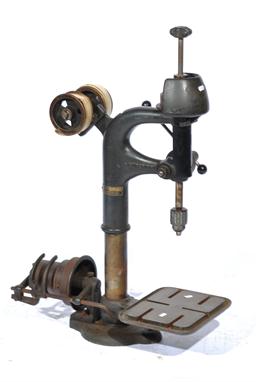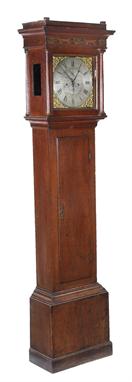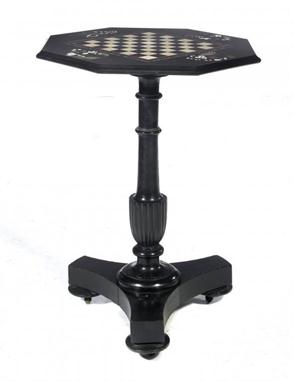We found 30663 price guide item(s) matching your search
There are 30663 lots that match your search criteria. Subscribe now to get instant access to the full price guide service.
Click here to subscribe- List
- Grid
-
30663 item(s)/page
Egptian Style Stone Triangular Pillar CapAn undated archaistic capstone, triangular in profile with incised scenes: to one face, Anubis and Thoth framing a jackal-headed figure kneeling before a jackal, hieroglyphs above; to the other face. a recumbent jackal on a hatched field, scarab before and hieroglyphs above. 1.3 kg, 13.5 cm (5 1/4"). Property of a London collector, acquired early 1960s. [No Reserve]Fine condition, some chipping to base.Starting Price: 5
Egyptian Large Glazed Composition Amulet of AmunLate Period, 500-332 BC. A large pale blue-glazed amulet depicting the god Amun, in striding pose with left foot advanced, hands at his side, bare-chested, wearing a shendyt kilt, tripartite wig, beard and double-plumed crown; a pillar to the reverse. 22 grams, 98 mm (4"). Ex Dr. Peter Gray collection. Dr. Grey (d.1990) was a pioneer of mummy x-rays. Fine condition.Starting Price: £550
Egyptian Glazed Hieroglyphic ShabtiLate Period, 664-332 BC. A large, slender glazed composition shabti figurine for `Imen-ka`, in pale blue with tripartite wig and beard; agricultural implements held at the shoulders; square base and dorsal pillar; hieroglyphic text from Chapter Six of the Book of the Dead. 126 grams, 18 cm (7"). UK art market, acquired prior to 1980. Fine condition.Starting Price: £700
Egyptian Glazed `Isis is Beautiful` ShabtiLate Period, 664-332 BC. A glazed composition shabti in deep green with strong facial detail, tripartite wig and beard; agricultural implements (flail, hoe and seed bag) held at the shoulders; square base and dorsal pillar; hieroglyphic text to the lower body reading `Illuminating the Osiris` and `Isis is beautiful`. 50 grams, 10.5 cm (4"). UK art market, acquired prior to 1980. Fine condition, old repair to legs.Starting Price: £300
Egyptian Blue-Glazed Hieroglyphic Shabti30th Dynasty, 380-343 BC. A large glazed composition shabti figurine in deep blue with strong facial detail, tripartite wig and beard; agricultural implements held at the shoulders; square base and dorsal pillar; hieroglyphic text to the lower body; truncated at the knees and mounted on a custom-made display stand. 289 grams, 14.5 cm including stand (5 3/4"). Ex Dubois collection, Paris. Fine condition.Starting Price: £250
Roman Marble Relief Plaque with Gladiators2nd-3rd century AD. A marble plaque depicting, in relief, two gladiators fighting to the death; the left-hand figure falling to the floor, leaning on his outstretched left arm; the right-hand figure standing over him in an active, striding pose, poised to attack, a dagger in his left hand, and a shield in his right; both figures dressed in short tunics; a post or narrow pillar to the left. 744 grams, 19 cm (7 1/4"). UK art market, acquired prior to 1980. Fine condition, part of a larger piece.Starting Price: £400
An 18th/19th century 7.5 inch brass square clock dial with chapter ring set with Roman numerals and with cherubic spandrels set with five pillar twin fusee movement, now set within a carved oak case incorporating 17th century elements with foliate carved detailing and caryatid mounts, case height 65cm.
*Roberts (David). A collection of fifteen ‘half-plate’ illustrations originally published in ‘Sketches in Egypt & Nubia’, 1847, uncoloured lithographs, some marginal chipping and fraying, some spotting, together with several pages of descriptive text and two half titles, each image approx. 260 x 360mm. The images comprise of :- Pyramids of Geezeh from the Nile, Statues of Memnon in the Plain of Goorna at Thebes, At Luxor: Thebes, Side View of the Great Sphinx, Ruins of Maharraka Nubia, Pompey’s Pillar, Temple of Dakke in Nubia, Abyssinian Slaves at Korti, Cleopatra’s Needle, Temple of Wady Kardassy Nubia, Ruins of Luxor from the South-West, Excavated Temple of Gyrshe Nubia, Temple of Tafa in Nubia, The Sanctuary of the Great Temple of Aboo-Simbel Nubia, [and] Approach to the Temple of Wady Saboua Nubia. (15)
Harry Kernoff RHA (1900-1974)JEWISH NEW YEAR, 1975, NELSON`S PILLAR & GPO, DUBLIN, 1935 and DAVY BYRNE`S BACK SNUG, 1936 (SET OF 3)woodcut; (1); print; (2)Jewish New Yeat signed in the margin in green ink lower centre; other two works with title and signature printed in the lower margins4.5 by 5.5in., 11.43 by 13.97cm.Dimensions of Nelson`s Pillar & GPO, Dublin, 1935 and Davy Byrne`s Back Snug, 1936 8.75 by 5.75in each. All framed.
Four pieces of Mauchline ware, comprising; a thimble egg (Dunkeld House), 5.5cm, a cylinder form sewing compendium (Berwick) with three division reel, needlecase and thimble mount, 13.5cm, a pillar box style reel box (Photographic – East Beach, Felixstowe), 9cm high, and a gold ground thimble egg (Nurse and Child Rocks, Giants Causeway), 7cm. (4)
A George III oak eight-day longcase clock with unusual chapter ring, Charles and Edward Gillet, Manchester, late 18th century, the four pillar movement with anchor escapement and hour striking on a bell controlled by locking pins fitted to the strike great wheel, the 12 inch square brass dial with subsidiary seconds and calendar dials to the symmetrical scroll engraved centre within applied Roman numeral chapter ring with Arabic five minutes to outer track and unusual half hour markers which comprise of letters to form the name JOSEPH JEPSON the lower edge signed Cha`s & Edw. Gillet, Manchester, the angles with rococo scroll cast spandrels, the case with ogee shaped caddy surmount above cavetto moulded cornice, foliate fretwork frieze and columns flanking the square hood door, the trunk with shaped-top mahogany crossbanded caddy-moulded door flanked by quarter columns to front angles, on raised-panel fronted plinth base with ogee bracket feet, 217cm (85.5ins) high. The partnership between Charles and Edward Gillet is recorded in Baillie, G.H. Watchmakers & Clockmakers of the World as working circa 1790-1800. The name formed from letters positioned as half hour markers is highly unusual and probably spells out the name of the original owner.
An Edwardian inlaid mahogany quarter chiming eight-day longcase clock, unsigned, early 20th century, the four pillar triple train movement chiming the quarters on a choice of either eight bells or four gongs and striking the hour on a further gong, the 12.5 inch brass break-arch dial with subsidiary seconds dial to the matted centre within applied silvered Roman numeral chapter ring with fleur-de-lys half hour markers and Arabic five minutes, the angles with winged cherub head and scroll cast spandrels and with chime selection switch at three o`clock, the arch with subsidiary CHIME/SILENT selection dial flanked by scroll cast mounts, the swan neck pedimented case with foliate inlay above brass Corinthian pillars and rectangular scroll pierced sound frets to sides, the trunk with shallow-arch door decorated with a drapery swag above elaborate tall foliate scroll marquetry cartouche within satinwood banded surround, on plinth base with conforming marquetry panel and moulded skirt incorporating shaped apron and bracket feet, 234cm (92ins) high.
An unusual mahogany cased gilt brass eight-day longcase domestic regulator, Ernest Mortimer Thomas, dated 1962, the four pillar movement with hour-glass shaped pierced frontplate and conforming large diameter backplate with Harrison`s maintaining power, deadbeat escapement and six-spoke wheel crossings, regulated by steel-alloy rod pendulum with large diameter cylindrical bob supported via `T` bar suspension from scroll pierced brackets fitted to the circular movement supporting plate screwed to the rear of the case, with signature Ernest Mortimer Thomas 1962 to centre and scroll decorated spandrel projections to angles, the 13 inch pierced slender silvered Roman cartouche numeral chapter ring supported via four elongated feet to the edge of the movement backplate and with conforming subsidiary seconds dial beneath twelve o`clock, the simple mahogany case with moulded cornice above bevel glazed front door and side panels, on tall plinth base with ogee moulded skirt, 203cm, (80inches) high.
A George III oak eight-day longcase clock, George Hewett, Martley, late 18th century, the four pillar rack and bell striking movement with 12 inch square brass dial with subsidiary seconds dial and signed signed George Hewett, Martley to the scroll engraved silvered centre within applied Roman numeral chapter ring with concentric calendar to the inner track and Arabic five minutes, the angles with scroll cast spandrels, in a case with cavetto moulded cornice and three-quarter columns to hood above rectangular caddy moulded door to trunk, on plain plinth base with moulded skirt, 198cm (78ins) high.
An oak eight-day longcase clock, the dial bearing signature for Springer, Stockport, 18th century and later, now with 19th century four pillar rack and bell striking movement fitted to an 11 inch square brass dial with ring turned calendar aperture to the foliate scroll engraved matted centre within applied Roman numeral chapter ring with fleur-de-lys half hour markers and bearing signature Springer, STOCKPORT to lower edge, the angles with female mask and scroll cast spandrels, now in a case with ogee moulded caddy above conforming cornice, blind fret fronted frieze and turned columns flanking dial, the trunk with shaped top door over plain plinth base with moulded skirt incorporating bracket feet, 206cm (81inches) high.
A walnut eight-day longcase clock, mid 18th century and later, the 19th century four pillar rack and bell striking movement with 12 inch white painted Roman numeral break-arch dial with subsidiary calendar and seconds dials and bearing signature Leddgeer, Norwich to centre, with game bird painted spandrels and conforming landscape with hunstman and hound to arch, now in an earlier case with later swan neck crest above moulded cornice and three-quarter columns to hood, the trunk with break-arch crossbanded door, on conforming plinth base with moulded skirt, 226cm (89ins) high.
An ebonised fusee dial wall timepiece, bearing signature for Arnold and Lewis, Manchester, early 20th century, the four pillar single chain fusee movement stamped W&H Sch. for Winterhalter and Hoffmeyer to backplate, the 12 inch cream painted Roman numeral dial bearing signature ARNOLD & LEWIS, MANCHESTER to centre within spun brass glazed bezel and turned wood surround, the rear box case with side door and pendulum access flap to the curved base, 40cm (15.75ins) diameter overall.
A Continental Dutch striking giltwood `sunburst` wall clock, unsigned, probably Swiss, circa 1800, the eight-day two train four pillar movement with verge escapement and strikework mounted on the backplate for sounding the hours on two different bells at both the hour and half hour, the 9.5 inch convex white enamel Roman numeral dial with pierced brass hands and turned gilt surround, the case of elaborate sunburst form fitted with box to rear with side doors and pendulum access flap to the curved base.
A mahogany fusee dial wall timepiece, C. Banyard, Outwell, circa 1830, the four pillar single fusee movement with 12 inch cream painted convex Roman numeral dial signed C. BANYARD, OUTWELL to centre within cast brass convex-glazed bezel and turned wood surround, the rear box case with side door and pendulum access flap to the curved base, 36cm (14.25ins) diameter overall.
A Victorian carved walnut bracket clock, unsigned, late 19th century, the four pillar twin chain fusee gong striking movement with rise/fall regulation and pendulum holdfast to backplate, the 5 inch wide rectangular silvered Roman numeral dial with fine foliate scroll engraved infill to lower spandrels and around the subsidiary STRIKE/SILENT and SLOW/FAST regulation dials to the extended upper margin, the case with tied swag and acanthus carved decoration to caddy surmount above bevel glazed front door with canted silvered brass fillet insert flanked by fluted canted angles and pierced rectangular frets to sides, on acanthus carved moulded skirt base with squab feet, 35.5cm (14ins) high.
A Victorian carved oak domestic posting box in the form of a pillar box, date stamped for 1882, the hexagonal section top with central dome, above a slot to the front with brass flap inscribed `LETTERS`, the cylindrical body with hinged door with brass framed window, a printed paper within giving postal times, the circular section base with brass diamond date panel, 38cm high
E. STEVENS, BOSTON AN 18TH CENTURY OAK LONGCASE CLOCK, the hood with moulded pediment over an arched glazed door, flanked by twin pilasters with brass capitals, 8-day four pillar mechanism with bell strike, faced by an arched brass dial with moon ph" ase, silvered chapter, subsidiary seconds and calendar, 2m high
W** S** AN EARLY VICTORIAN NORTHERN ENGLISH/SCOTTISH MAHOGANY LONGCASE CLOCK having 8-day four pillar mechanism with false plate faced by an arched painted dial with subsidiary seconds and calendar, hood with swan neck broad trunk with shaped waist" door inlaid on box base with bracket feet, 2.3m
SUMMERHAYES, ILMINSTER A PRINCIPALLY 19TH CENTURY OAK 8-DAY COTTAGE LONGCASE CLOCK, having hood with moulded pediment, later caddy flank pilasters with carved gilt wood capitals, waist door and box base on later plinth, four-pillar mechanism with an" chor escapement, no false plate, faced by a re-painted 12" dial, 2.05m high
A VICTORIAN ASHFORD BLACK MARBLE CHESS TABLE, DERBYSHIRE the octagonal slate top inlaid in coloured hardstones, including malachite with a square frame and four sprays of lily of the valley and other flowers, on turned, ebonised wood pillar with reeded knop, platform and feet, 78cm h, 65cm w In good condition, the pillar with shrinkage cracks on the socle, the pillar/base apparently original
-
30663 item(s)/page



















































